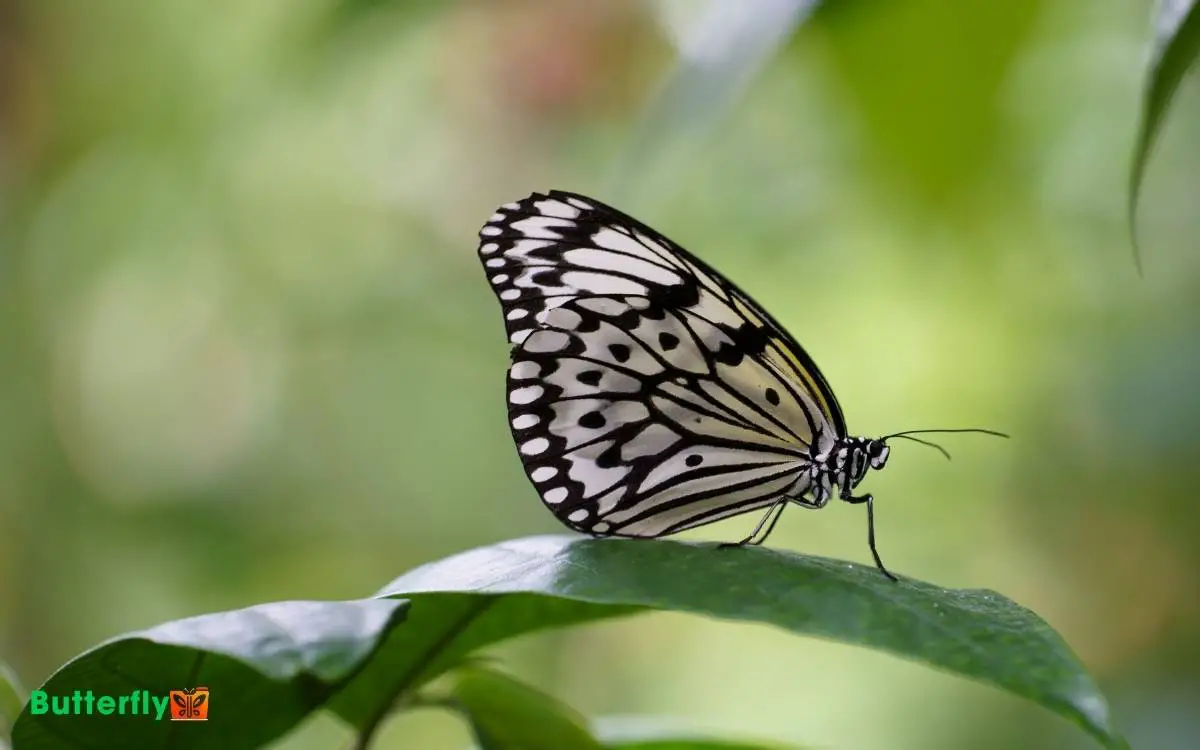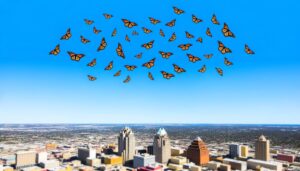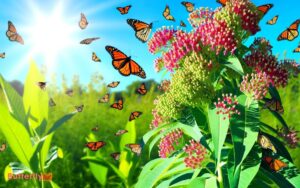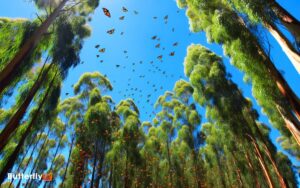Black and White Monarch Butterfly: Rare Beauty Explained!
You’ll recognize the black and white monarch butterfly by its characteristic black veins and white spots on the wings, with a wingspan of 8.9 to 10.2 centimeters.
These butterflies inhabit temperate and tropical zones, favoring meadows and deciduous forests, and migrate from North America to central Mexico. Their life cycle includes stages from egg to caterpillar to pupal and finally, adult butterfly.
Genetic variations arise from mutations, gene flow, and natural selection. Environmental influences, like habitat loss and pesticides, pose threats.
Conservation efforts focus on habitat restoration and public awareness. Further exploration reveals their significant role in ecosystems and more.

Key Takeaways
Appearance and Characteristics
The Black and White Monarch Butterfly features distinct black and white wing patterns, contrasting sharply with its more commonly known orange and black counterpart.
You’ll notice that the forewings and hindwings display a mosaic of black veins and white spots, creating a striking visual effect.
Its wingspan typically measures between 8.9 to 10.2 centimeters. The body is primarily black with white markings adorning the head and thorax.
Unlike the orange variant, this butterfly’s coloration may offer different survival advantages, possibly linked to geographic or environmental factors.
The antennae are black with white tips, aiding in sensory perception. Observing these unique characteristics allows you to differentiate it easily from other monarch butterflies, enhancing your understanding of its distinct appearance.
Habitat and Range
You’ll find the Black and White Monarch Butterfly inhabits diverse regions, primarily within temperate and tropical zones. It prefers areas with moderate temperatures and abundant milkweed, essential for its lifecycle.
Understanding its migratory patterns reveals critical insights into its survival strategies and ecological adaptations.
Geographic Distribution Patterns
Black and White Monarch Butterflies inhabit a variety of ecosystems, ranging from temperate coastal regions to tropical forests. You’ll find them distributed across North America, Central America, and parts of South America.
They occupy diverse habitats including meadows, grasslands, and deciduous forests. This species demonstrates a wide range of adaptability, making use of various nectar sources and host plants.
In the United States, their presence is particularly noted in the eastern states, extending into southern Canada. During migration, they travel vast distances, covering thousands of miles.
While they primarily reside in regions with abundant milkweed, their geographic distribution can vary seasonally. Understanding these patterns helps in conservation efforts by pinpointing critical habitats essential for their survival.
Preferred Climatic Conditions
Although they’re highly adaptable, black and white monarch butterflies thrive best in warm, temperate climates with moderate humidity levels.
You’ll find that they prefer temperatures ranging from 75 to 85 degrees Fahrenheit. These conditions support their metabolic processes, aiding in growth and reproduction.
To flourish, they also require access to milkweed plants, their primary food source during the larval stage.
Their ideal habitats include open fields, meadows, and areas with abundant sunlight. It’s important to understand that extreme temperatures either too hot or too cold can disrupt their life cycle and reduce survival rates.
In addition, consistent humidity levels help maintain their hydration and wing integrity. Therefore, favorable climatic conditions are essential for their sustainability and ecological success.
Migratory Behavior Insights
Many black and white monarch butterflies undertake extensive migrations to find suitable habitats and optimize their survival and reproductive success. These migrations can span thousands of miles and involve several generations of butterflies.
You’ll observe that their migratory patterns are influenced by:
- Temperature Fluctuations: Monarchs move to avoid extreme cold or heat, ensuring favorable conditions for development.
- Food Availability: They seek regions with abundant milkweed, essential for larval growth and adult sustenance.
- Reproductive Sites: Monarchs migrate to areas conducive to mating and laying eggs, ensuring future generations.
Understanding these patterns helps in conservation efforts. Migratory behaviors are critical for their lifecycle, making it essential for you to recognize the importance of protecting migratory corridors and habitats.
Life Cycle and Behavior
You’ll observe the black and white monarch butterfly’s life cycle starting from the egg stage, progressing to a caterpillar.
During the pupa transformation process, significant metamorphosis occurs.
Egg to Caterpillar
When a black and white monarch butterfly lays its eggs on milkweed plants, the initial stage of its life cycle begins, characterized by the development of the larva within a few days. As the egg hatches, the larva, known as a caterpillar, emerges.
You’ll notice the caterpillar’s voracious appetite for milkweed, which serves as its sole food source.
To understand this stage better, consider these three key points:
- Egg Duration: The eggs typically hatch within 3-5 days.
- Larval Growth: The caterpillar goes through five instar stages, growing rapidly.
- Feeding Behavior: Caterpillars consume large quantities of milkweed to accumulate energy for the next stage.
Pupa Transformation Process
During the pupa stage, the caterpillar transforms into a chrysalis, undergoing a complete metamorphosis to emerge as a black and white monarch butterfly. This process involves the breakdown and reorganization of the caterpillar’s body structures.
Inside the chrysalis, cellular activities rapidly convert the larva into an adult form. The duration of this transformation is typically 10-14 days, depending on environmental conditions.
The table below outlines key aspects of the pupa stage:
| Stage | Duration (Days) | Key Activities |
|---|---|---|
| Early | 1-3 | Formation of chrysalis |
| Mid | 4-10 | Breakdown of larval structures |
| Late | 11-14 | Formation of adult features |
Monitoring these stages can provide valuable insights into the metamorphic processes leading to the butterfly’s emergence.
Adult Monarch Migration
Each year, millions of black and white monarch butterflies undertake an extraordinary migration spanning thousands of miles. You’ll find these butterflies traveling from North America to central Mexico.
This migration is crucial for their survival. Monarchs use environmental cues and an internal biological clock to guide their journey.
During migration, they exhibit specific behaviors:
- Thermal Soaring: Monarchs utilize rising warm air currents to conserve energy.
- Nectar Feeding: They increase their fat reserves by feeding on nectar from various flowers.
- Roosting: Monarchs rest in communal roosts during the night to stay warm and safe.
These behaviors ensure they reach their wintering grounds successfully. Understanding this migration helps in conserving their habitats and securing the species’ longevity.
Genetic Variations
Genetic variations in the Black and White Monarch Butterfly result from mutations, gene flow, and natural selection. Mutations alter the DNA sequence, creating new alleles that may affect traits such as wing pattern and coloration.
Gene flow occurs when individuals migrate and interbreed with different populations, introducing new genetic material. Natural selection then acts on these variations, favoring traits that enhance survival and reproduction.
For instance, certain color patterns might offer better camouflage or mate attraction. By understanding these mechanisms,
You’ll appreciate how genetic diversity contributes to the adaptability and resilience of the Black and White Monarch Butterfly, ensuring its continued evolution and survival in various environments.
Environmental Influences
You should consider how habitat and climate changes greatly impact the black and white monarch butterfly’s migration patterns and survival rates.
Pollution and pesticide use also pose direct threats to their health and reproductive success. Understanding these environmental influences is vital for conservation efforts.
Habitat and Climate Changes
Rapid climate shifts and habitat destruction have greatly impacted the distribution and survival of the black and white monarch butterfly.
You’ll notice that these environmental changes lead to several critical challenges:
- Habitat Loss: Urbanization and deforestation reduce the availability of milkweed, essential for monarch reproduction.
- Temperature Variability: Fluctuating temperatures disrupt migration patterns and breeding cycles, leading to population decline.
- Extreme Weather Events: Increased frequency of storms and droughts can devastate local monarch populations.
These factors collectively threaten the black and white monarch’s ability to thrive. By understanding these influences, you can better appreciate the importance of conservation efforts.
Maintaining stable habitats and mitigating climate change are crucial to ensuring the survival of this remarkable species.
Pollution and Pesticide Impact
Pollution and pesticide use further exacerbate the challenges faced by the black and white monarch butterfly, adding toxic exposure to their already stressed environments.
When you introduce pollutants like heavy metals and industrial chemicals into their habitats, you disrupt their physiological processes.
Pesticides, particularly neonicotinoids, pose a significant threat by affecting their nervous systems, leading to disorientation and mortality.
You may not realize that even sub-lethal doses can weaken their immune systems, making them more susceptible to diseases and parasites.
The decline in milkweed, their sole larval food source, is often linked to herbicide use. By understanding these impacts, you’ll see how important it’s to mitigate pollution and pesticide usage to protect these delicate pollinators.
Role in Ecosystem
Monarch butterflies, including the black and white variants, play a significant role in pollination, contributing to the health and diversity of various ecosystems.
By transferring pollen from one flower to another, they facilitate plant reproduction, which is essential for maintaining biodiversity.
Specifically, they:
- Support Plant Reproduction: Monarchs help in the fertilization of many flowering plants.
- Sustain Food Webs: They provide a food source for birds, insects, and other predators.
- Promote Genetic Diversity: Pollination by monarchs encourages genetic variability in plant populations.
You’ll find that these butterflies are essential for the survival of many plant species, which, in turn, support a wide range of animal life. Their role underscores the interconnectedness of ecological systems.
Conservation Efforts
Given their critical ecological roles, coordinated conservation efforts are imperative to safeguard the survival of black and white monarch butterflies.
You can contribute by engaging in habitat restoration, supporting sustainable agricultural practices, and raising awareness.
Effective strategies include planting native milkweed, reducing pesticide use, and participating in citizen science projects.
Here’s a brief overview of key conservation actions:
| Conservation Action | Objective | Importance |
|---|---|---|
| Habitat Restoration | Replant native flora | Provides essential resources for life stages |
| Sustainable Agriculture | Minimize chemical use | Reduces harmful exposure to pesticides |
| Public Awareness Campaigns | Educate and engage communities | Fosters widespread support for conservation |
| Citizen Science Projects | Data collection and monitoring | Enhances understanding of population dynamics |
Threats to Survival
Black and white monarch butterflies frequently face several significant threats that jeopardize their survival. You’ll find that these threats include habitat loss, climate change, and pesticide use.
- Habitat Loss: Urbanization and agricultural expansion reduce the availability of milkweed, the sole food source for caterpillars.
- Climate Change: Variations in temperature and weather patterns disrupt migration and breeding cycles, leading to decreased population stability.
- Pesticide Use: Chemicals like neonicotinoids are harmful to monarchs, causing both direct mortality and sub-lethal effects that impair their development and reproduction.
Each of these factors independently and collectively contributes to the decline in black and white monarch butterfly populations. Recognizing these threats is essential for developing effective conservation strategies to safeguard their continued existence.
Research and Studies
To better understand the challenges facing black and white monarch butterflies, researchers have conducted extensive studies on their migratory patterns, breeding habits, and environmental stressors.
Scientists track their long-distance migrations using GPS tagging, revealing critical stopover sites.
Breeding habits are analyzed through controlled observations, highlighting specific milkweed species essential for larval development.
Environmental stressors, including pesticide exposure and habitat loss, are assessed using both field experiments and laboratory simulations.
Researchers have found that climate change affects their phenology, leading to mismatched timing between migration and resource availability.
These studies aim to identify conservation strategies to mitigate threats, ensuring the survival of this unique butterfly variant. Your understanding of these scientific efforts is essential for appreciating conservation challenges.
Observing in the Wild
While observing black and white monarch butterflies in their natural habitat, you’ll need to focus on their unique behaviors and interactions with the environment.
Pay close attention to their feeding habits, migration patterns, and mating rituals. These butterflies exhibit specific behaviors that help in their survival and reproduction.
To enhance your observations, consider these three key points:
- Feeding Preferences: Monitor which flowers they frequent for nectar, noting the plant species.
- Migration Patterns: Track their flight paths and resting spots during migration seasons.
- Mating Behavior: Observe courtship displays and pair formations to understand reproductive strategies.
Using these focused observations, you can gather valuable data on the ecological roles and adaptations of black and white monarch butterflies in their ecosystems.
Similar Species
As you observe these behaviors, it’s important to differentiate the black and white monarch butterfly from similar species that share its habitat.
You might encounter the viceroy butterfly, which mimics the monarch’s coloration. However, the viceroy has a distinct horizontal black line across its hind wings.
Another look-alike is the queen butterfly, which has more orange and lacks the monarch’s white spots on its black wing edges.
Additionally, the painted lady butterfly can confuse observers due to its orange and black patterns, but it has unique, small blue-centered eyespots on its hind wings.
How to Help
Engaging in conservation efforts can greatly aid in the survival of the black and white monarch butterfly. You can contribute by creating a habitat conducive to their lifecycle.
Here are three effective actions you can take:
- Plant Native Milkweed: Monarchs rely on milkweed for laying eggs and nourishment during their larval stage.
- Avoid Pesticides: Chemicals can be detrimental to both adult butterflies and their larvae.
- Support Conservation Programs: Participating in or donating to organizations focused on monarch butterfly preservation can amplify collective efforts.
Conclusion
Imagine you’re a scientist, peering through a microscope at a black and white monarch butterfly. You’re not just seeing a creature, but a living proof of nature’s delicate balance.
Its life cycle, genetic variations, and environmental influences weave a complex tapestry. By studying these intricate patterns, you help safeguard its fragile existence.
Like a guardian of a rare manuscript, your careful attention guarantees the butterfly’s story continues to be written, one generation at a time.






